The year was 1941. National Comics was in a boom period like no other, practically owning the comic-book industry thanks to their unprecedented one-two punch of Superman and Batman. After some three and a half years of success, the company decided to put a big promotional push behind a new character, and even anoint it as the successor to the Man of Steel and the Caped Crusader, claiming in a house ad that the new superhero “is certain to become as popular as the two great leaders in the comic field, SUPERMAN AND BATMAN.” And why not? After all, the creator of the new feature, artist Jack Burnley, had been toiling away on both Superman and Batman for over a year as one of their most dependable ghost artists, particularly on SUPERMAN. They knew he could deliver the goods, so a brand-new character from Burnley should be money in the bank, right?
Unfortunately, it didn’t quite work out that way for Burnley’s new character, the quintessential Golden Age also-ran, Starman. Let’s take a look at the Astral Avenger’s debut in ADVENTURE COMICS #61 (April 1941), and see if we can pinpoint where it all went wrong.

Drawn by Jack Burnley (although the identity of the writer is lost to the ages), Starman’s inaugural appearance opens with a wave of destructive sabotage across the United States. Everything from telegraph wires to power-generating dynamos spontaneously and mysteriously burst into flame.
At his wit’s end, the FBI’s “ace troubleshooter” Woodley Allen decides to call for the one man who can help:
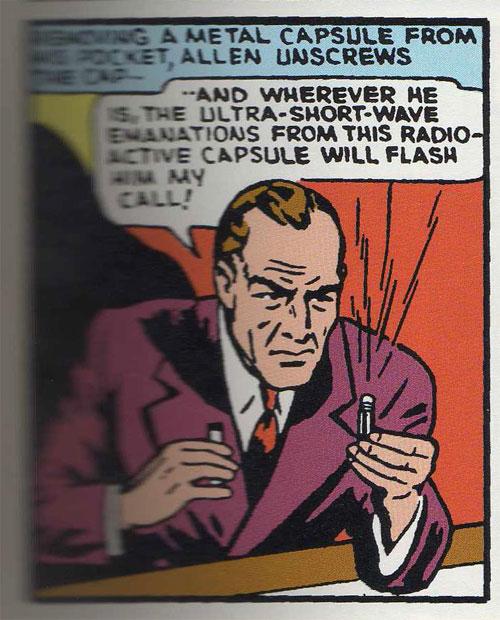
Not exactly the Batsignal, but, hey, it’s something. Woodley there better hope he’s been wearing a lead suit.
Meanwhile, foppish hypochondriac Theodore Knight is sniffling his way through a high-falutin’ dinner with girlfriend Doris Lee, when the city unexpectedly goes dark. At the same time, a metal cylinder Knight carries within a hidden holster begins to vibrate, alerting him that he’s being summoned.

Knight makes his excuses and looks for a place to change clothes, transforming himself into — wait for it — Starman!
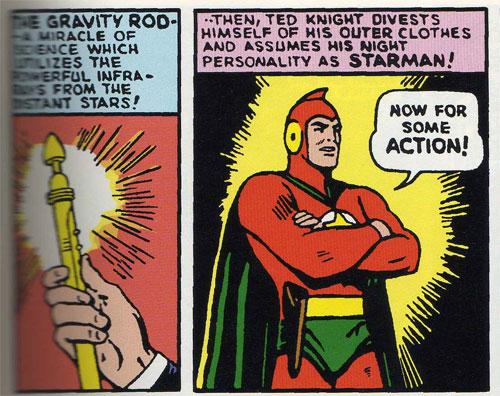
This, by the way, is all the origin we ever get for Ted Knight:

Ah. Superman gets “rocketed to Earth from an exploding planet.” Batman gets “parents were murdered by criminals.” Starman gets “solid scientific research.” How exciting. It’ll make an excellent movie. Ted definitely gets rooked in the origin department.
Anyway, courtesy of his invention, the amazing Gravity Rod, Starman flies out to his secret meeting place with Woodley Allen: an old abandoned shack. There, Woodley tells Starman who’s behind the wave of sabotage: a sinister band of conspirators known as the Secret Brotherhood of the Electron. Sounds like they have to pay dues and have weekly lodge meetings. Starman somehow deduces from this that the Brotherhood must have some sort of device that allows them to nullify ordinary electricity.

Hovering above the city, he conveniently notices some electrical discharge coming from a mountain range below, and investigates, discovering the secret lair of the Secret Brotherhood of the Electron, who have helpfully painted a large lightning bolt on the heavy steel door of their compound.

Starman busts in and interrogates an Electron thug, who quickly gives up the name of the operation’s boss, “an old guy known as Dr. Doog.” Starman locates Dr. Doog, but falls victim to Doog’s powers of hypnosis, finding himself “pinioned by a thought wall.”

Starman manages to resist the hypnosis, and evades Doog’s even more sinister scheme: a trap door. Ooooooooh, scary.
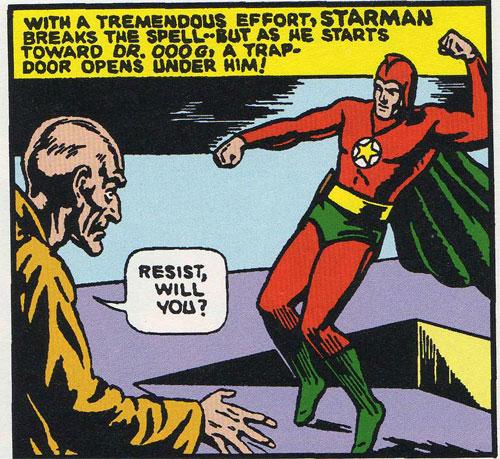
Next, Doog falls back on the old reliable hired goons, but Starman makes short work of them, although we’re not shown exactly how.
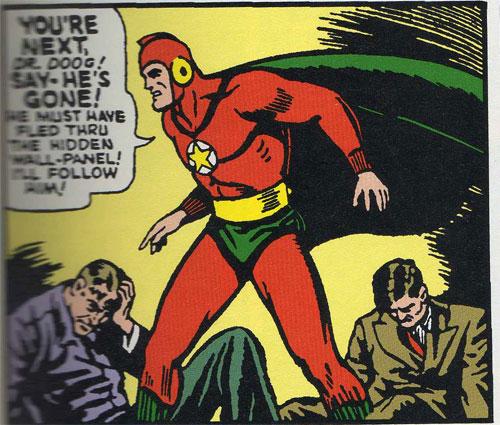
However, it’s been long enough for Doog to ready his final weapon, the devastating Ultra-Dynamo, but it’s no match for Starman’s Gravity Rod. And unluckily for Dr. Doog, in trying to escape, he forgets exactly where he’d installed his trap doors, and, well…
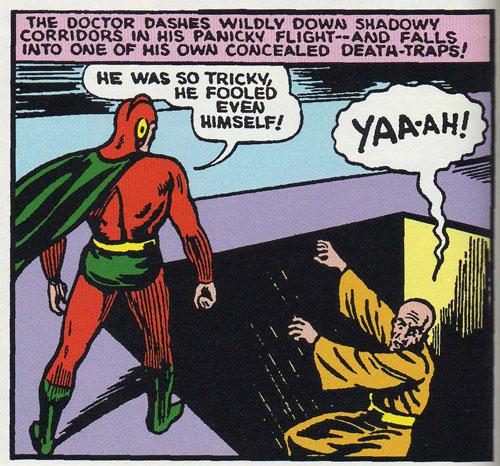
The crisis averted Starman changes back to Ted Knight and drops in on Doris for a little more abuse:
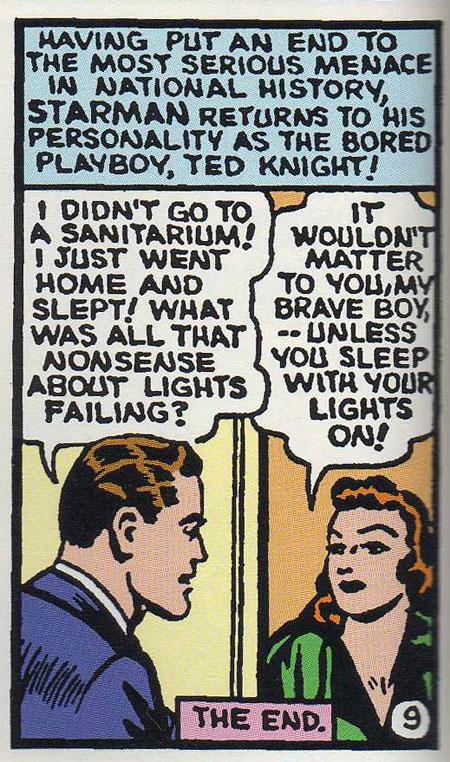
So what could Starman do exactly? Well, thanks to the Gravity Rod (later replaced by the Cosmic Rod), Starman was able to manipulate and control energy that the Rod somehow drew from stellar radiation, allowing him to fly, create force fields and protective spheres, expel destructive bursts of energy, levitate objects, and even manipulate the energy into shapes and forms, kind of like Green Lantern’s power ring. Otherwise, he was just a regular guy, with no real powers without his Cosmic Rod, although over time he gained the ability to manipulate the Rod mentally from a distance and even summon it to him, later explained as his having keyed the Rod’s frequency to his brainwaves.
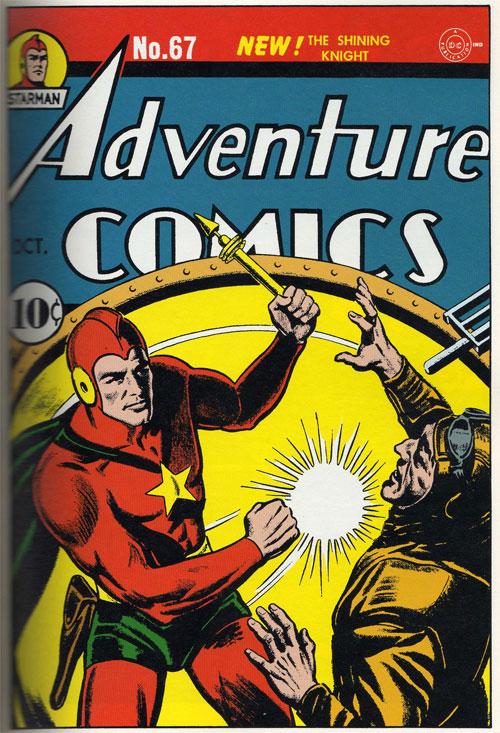
A word about his costume: Granted, it’s a little silly, and definitely old-fashioned, but there’s an almost art-deco elegance about it that’s always appealed to me, particularly the headpiece and the cape. I also always liked the very utilitarian detail of the leather holster for the Gravity Rod on the belt — it seemed like something he picked up at Sears after a mission where he needed both hands for something.
Unfortunately, as cool as his uniform was, Starman himself was pretty bland. The whole business of pretending to be a weak-kneed milquetoast around your girlfriend at least made some sense with Clark Kent. After all, he had real superpowers to try and hide. Ted Knight didn’t even bother wearing a mask, yet he had no problem completely eviscerating his own relationship in the hopes of allaying suspicions. Self-loathing much, there, Ted?
Burnley’s art was definitely well done and leagues better than most of the other work seen in comics of the time, but it too was a little staid, having neither the noirish moodiness of Bob Kane and Jerry Robinson’s Batman or the dynamic crackle of Kirby’s Captain America.
The biggest problem, though, were Starman’s enemies, an endless parade of nondescript scientists and saboteurs with no real flair or panache, there was The Light, Captain Vurm, Baron X, the Green Arab, the Singapore Stranglers, and the list goes on and on. The only real winner in Starman’s rogues’ gallery was The Mist, who made his debut in ADVENTURE COMICS #67 (October 1941.)

The Mist, another disgruntled scientist, had attempted to sell his “inviso-solution” to the U.S. Government during the previous World War but was turned down, and as a result was scheming for revenge. And I gotta side with the Mist on this one: seems to me an invisibility formula just might be something the military would want to invest in. The Mist went on a traitorous rampage, not only stealing all kinds of government secrets thanks to his inviso-solution, but going so far as to coat planes with the material and prepare them for a bombing run over factory districts in Pittsburgh and Bethelem, Pennsylvania (an oddly specific plan for comics, I might add). Starman stumbles across the plot trying to rescue a sightseeing Doris from a cave-in, that just happened to also be the location of the Mist’s secret lair.
Apprised of the situation, Starman downs the Mist’s invisible planes, then goes after the Mist himself, who had re-kidnapped Doris and fled the scene in his (surprisingly visible) “space-ship.”

Starman melts his way through the hull, then takes out the Mist rather easily with a right cross; after all, he is just a floating head.
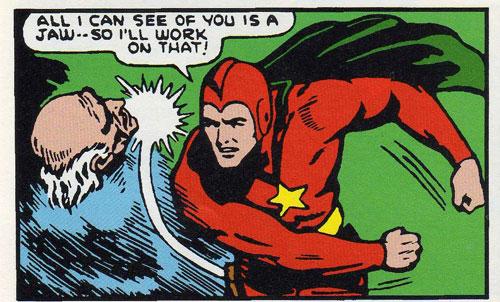
It’s the Mist’s visual design that sets him apart from the rest of Starman’s rather pedestrian antagonists. The floating, scraggly-haired head hovering above a swirl of mist and air is an innovative and creepy look for the comics of the time, even if it was revealed that he was only wearing an invisible cloak. When the character returned decades later, it would be revealed that repeated exposure to the inviso-solution had rendered him completely insubstantial rather than merely invisible.
National Comics clearly expected to go all the way with Starman, booting Hourman out of its popular Justice Society of America series in ALL-STAR COMICS to make room for him (also joining at the time was new character Dr. Mid-Nite, replacing Green Lantern, who had been awarded his own self-titled series).

However, if you’ll pardon the expression, Ted Knight’s star fell rather rapidly. He was booted from the covers of ADVENTURE COMICS after about a year or so, but remained a monthly feature in its pages for four more years, until 1946, when he was ousted in favor of Aquaman and Superboy stories. At about the same time. Starman found himself (along with the Spectre) unceremoniously and without explanation bumped from the JSA roster as well, their spots taken up by the returning Flash and Green Lantern.
When the JSA returned to comics pages in the 1960s, Starman was one of the first to be brought back, in part because he wasn’t a duplicate of a then-published DC hero like Hawkman or Flash, and no doubt also thanks to his unique and classic look.
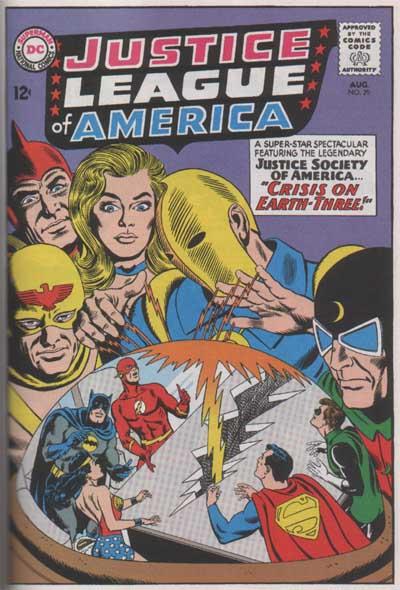
Starman was really the perfect character for those kinds of guest appearances: a flashy, colorful costume and a simple, visual power, but not much characterization to have to contend with. He had another brief moment in the spotlight in 1965, when he and Black Canary were given a two-issue teamup stint in BRAVE AND THE BOLD, written by Gardner Fox and drawn by Murphy Anderson, a couple of handsomely drawn but deadly dull stories that failed to set the world on fire.

They did, however, serve as inspiration for an intriguing connection between the two characters that wouldn’t be explored until decades later. By the 1970s, Starman was bumped again from the JSA, suffering a broken leg and handing over his Cosmic Rod to new JSA member the Star-Spangled Kid, for whom Ted later made his own version of the Rod, recrafting it into the Cosmic Converter Belt. The worst bit of retroactive history came with Roy Thomas’ handling of the character in ALL-STAR SQUADRON and INFINITY, INC., in which he declared that Ted Knight didn’t even invent the Gravity Rod himself, that he merely bought it. Fortunately, this idea would be dispensed with and ignored in the STARMAN series to come.
“STARMAN series to come,” you ask? Indeed, Ted Knight was far from the last to bear the name Starman — which we’ll begin to discuss next week…


Comments are closed.